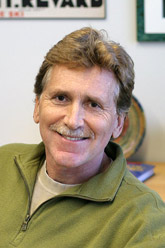
Handy Links
SLAC News Center
SLAC Today
- Subscribe
- Archives: Feb 2006-May 20, 2011
- Archives: May 23, 2011 and later
- Submit Feedback or Story Ideas
- About SLAC Today
SLAC News
Lab News
- Interactions
- Lightsources.org
- ILC NewsLine
- Int'l Science Grid This Week
- Fermilab Today
- Berkeley Lab News
- @brookhaven TODAY
- DOE Pulse
- CERN Courier
- DESY inForm
- US / LHC
SLAC Links
- Emergency
- Safety
- Policy Repository
- Site Entry Form

- Site Maps
- M & O Review
- Computing Status & Calendar
- SLAC Colloquium
- SLACspeak
- SLACspace
- SLAC Logo
- Café Menu
- Flea Market
- Web E-mail
- Marguerite Shuttle
- Discount Commuter Passes
-
Award Reporting Form
- SPIRES
- SciDoc
- Activity Groups
- Library
Stanford
Around the Bay
From the Director of LCLS: Working on Becoming Even Better

Over the first year and a half of LCLS operation we have moved full speed ahead, and earlier this year I was somewhat worried whether the FY11 budget would allow us to continue this strategy. A few weeks ago I breathed a sigh of relief when LCLS finally received its budget. We are grateful to the Office of Basic Energy Sciences for providing us with a 2011 budget that allows us to continue our aggressive schedule in commissioning instruments, operating them for users with adequate scientific and support staff, and improving our ability to characterize and improve the quality of the LCLS pulses.
It is a very exciting time that’s only going to get more exciting. We now have four experimental stations in user operation and are looking forward to the commissioning of the fifth instrument, X-Ray Correlation Spectroscopy (XCS), in the upcoming operating run which begins on June 9, and the commissioning of the Matter in Extreme Conditions (MEC) instrument in spring 2012.
To further improve the LCLS, earlier this year Norbert Holtkamp, the SLAC Associate Laboratory Director for the Accelerator Directorate, and I formed a working group co-lead by Zhirong Huang from the Accelerator Directorate and Jerry Hastings from the LCLS Directorate to develop an integrated research and development program for LCLS. While this R&D will be an ongoing effort and new projects will be continuously explored, we chose to present a first list to the LCLS Science Advisory Committee (SAC) on April 18-19. After listening to presentations of the identified projects by the lead SLAC scientists the SAC was asked to provide feedback on the importance of the different projects.
The SAC strongly encouraged us to move ahead with some key projects: (1) hard X-ray self-seeding which improves the present noisy pulses into well-behaved, more intense pulses ; (2) ultrafast diagnostics that can measure the time structure of the individual X-ray pulses which we currently do not know; (3) methods to accurately determine the time between the arrival of two pulses—for example, an optical “pump” pulse from a conventional laser that produces a new chemical state of interest and a later LCLS x-ray “probe” pulse which reveals how the chemical state changes with time; and (4) the development of X-ray detectors which can record pictures of the individual X-ray pulses scattered by a sample with improved quality and speed.
The SAC grouped the other presented R&D projects into three categories—projects that would offer general benefits to the entire user community, projects that would be important to a subset of users, and projects that would be important for LCLS-II and future free electron lasers. In the coming months we will take a closer look at the required funding for the various projects. We plan to aggressively move ahead with the top four projects and expect to also kick off others.
More generally, the SAC was very pleased with our continued efforts to improve LCLS. Clearly, the committee was fully engaged in the discussions and several members commented on the strong collaborative atmosphere between the X-ray and accelerator scientists engaged in LCLS, and I have to say that the speakers made me proud.
